AUTHORSHIP(COPYRIGHT)PRACTICE IN TRANSLATION Done
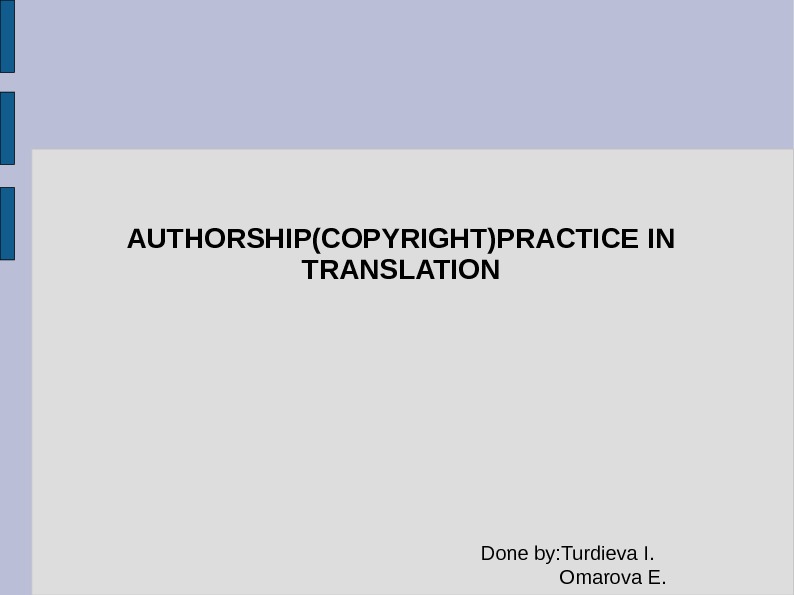
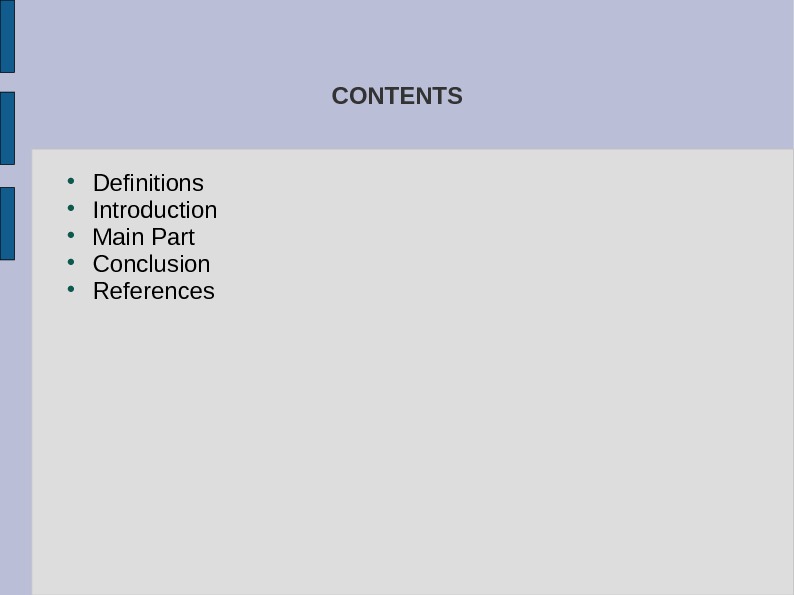
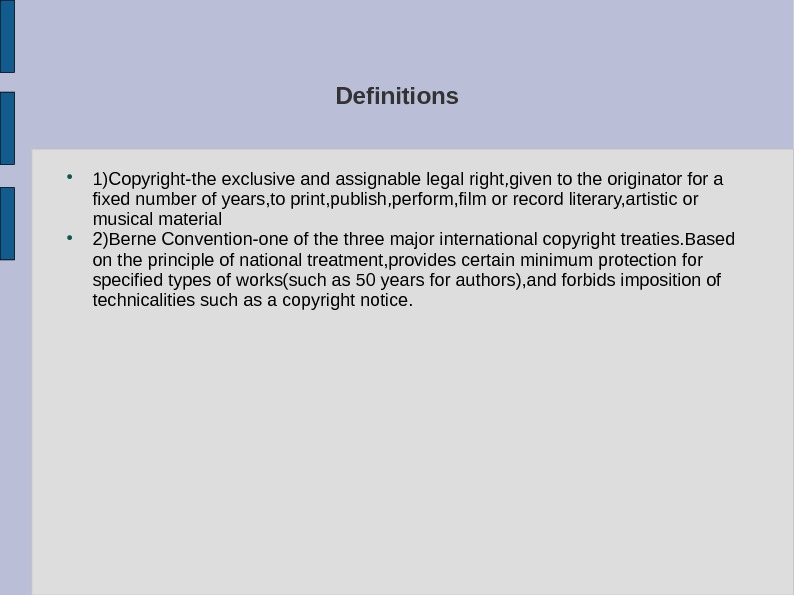
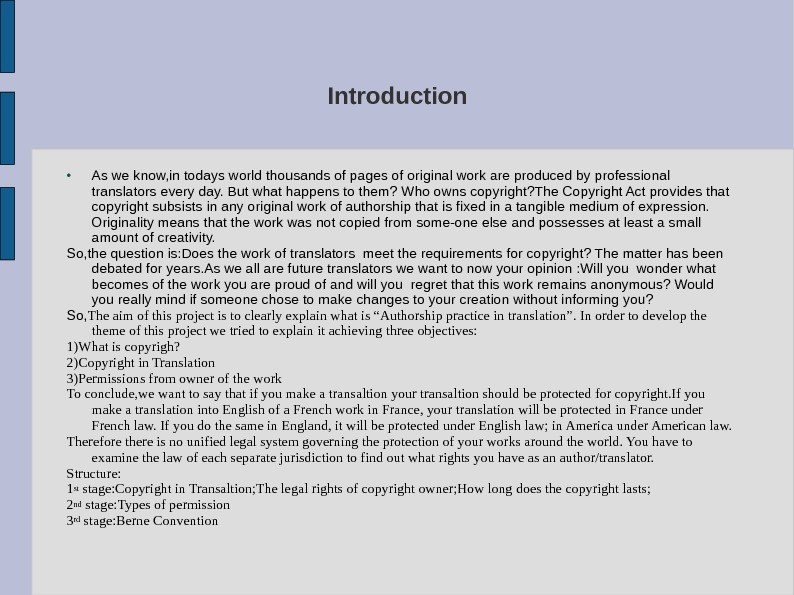
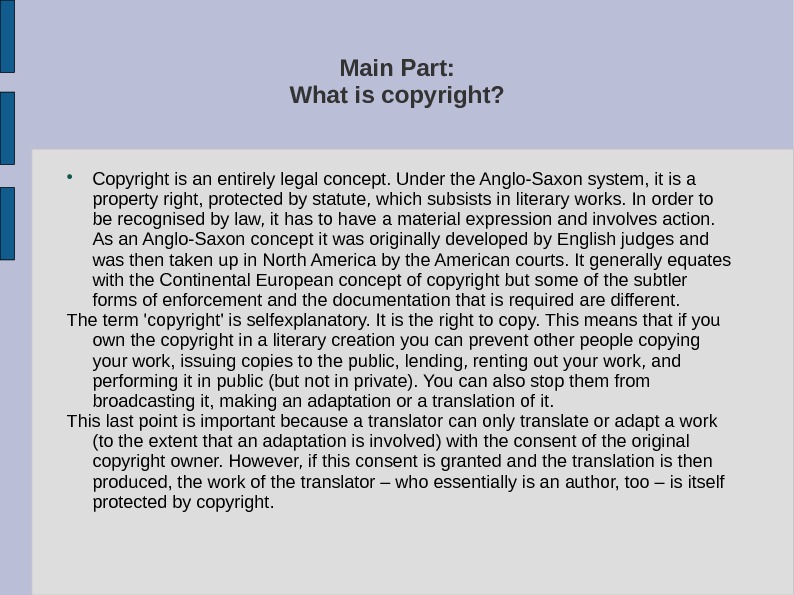
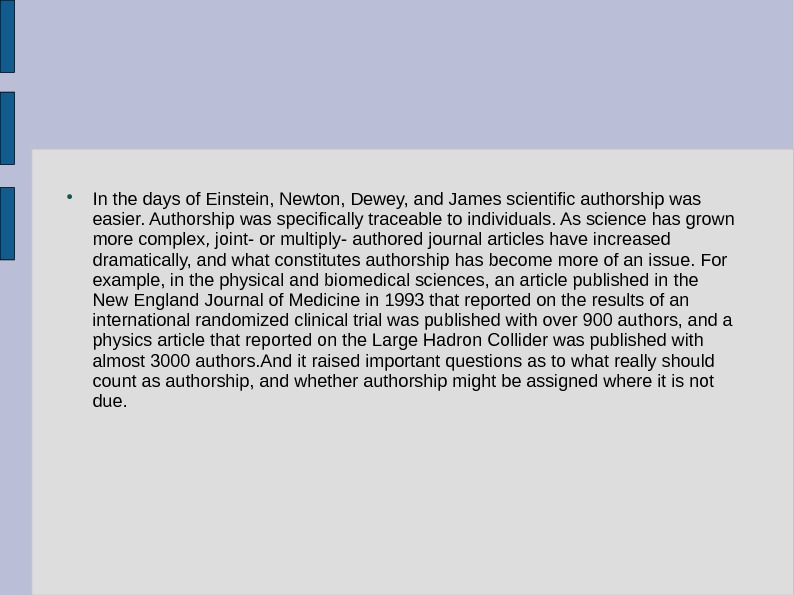
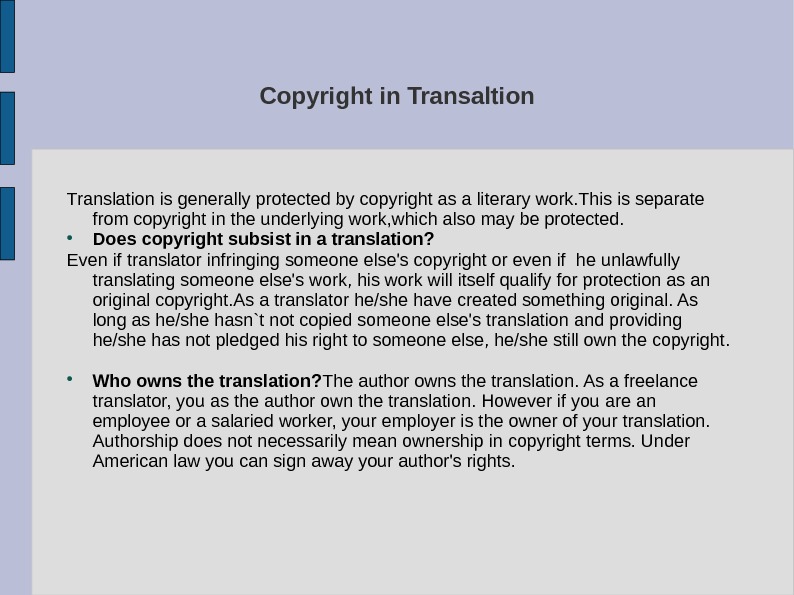
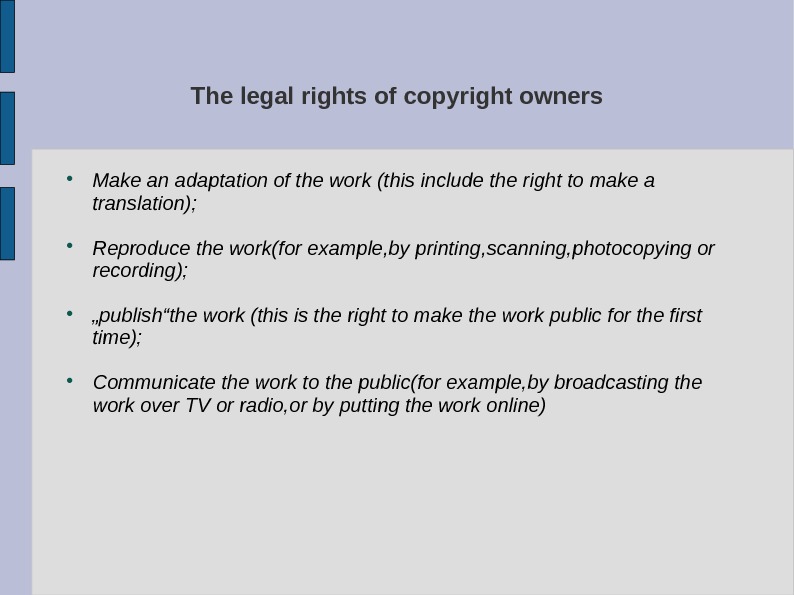
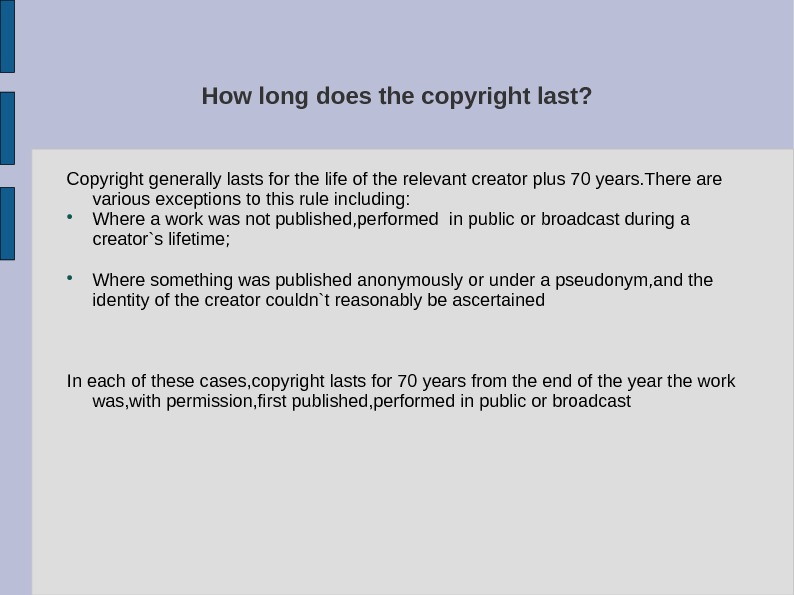

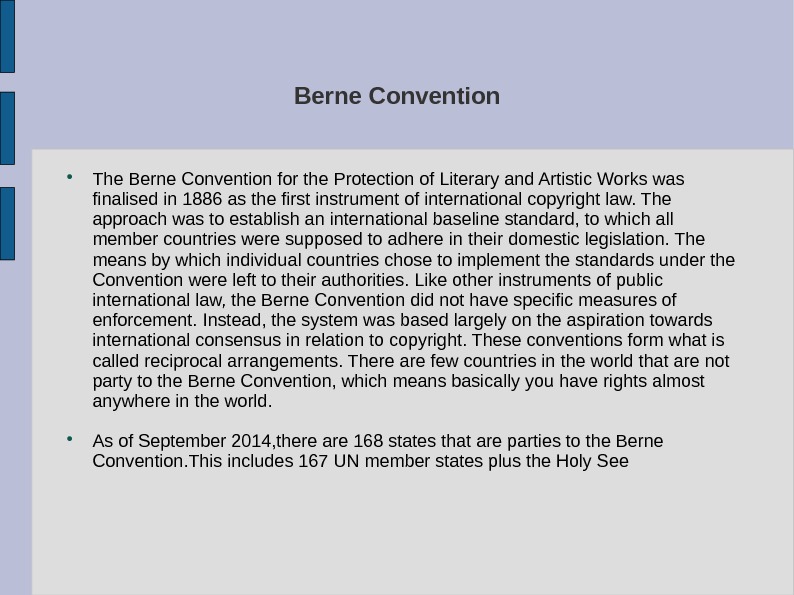
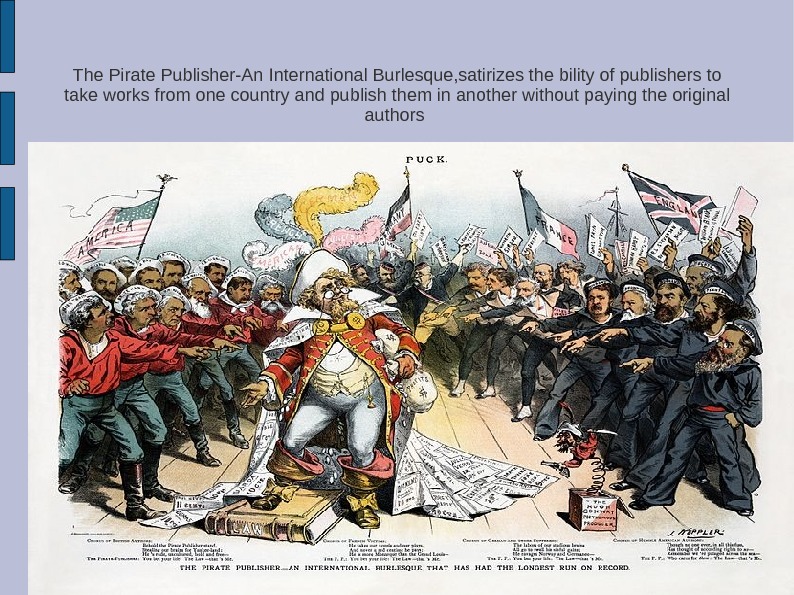
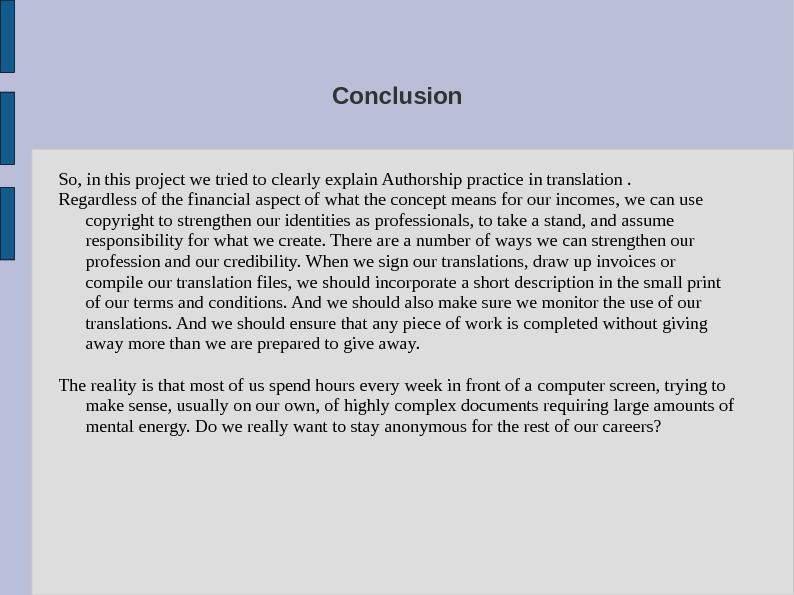
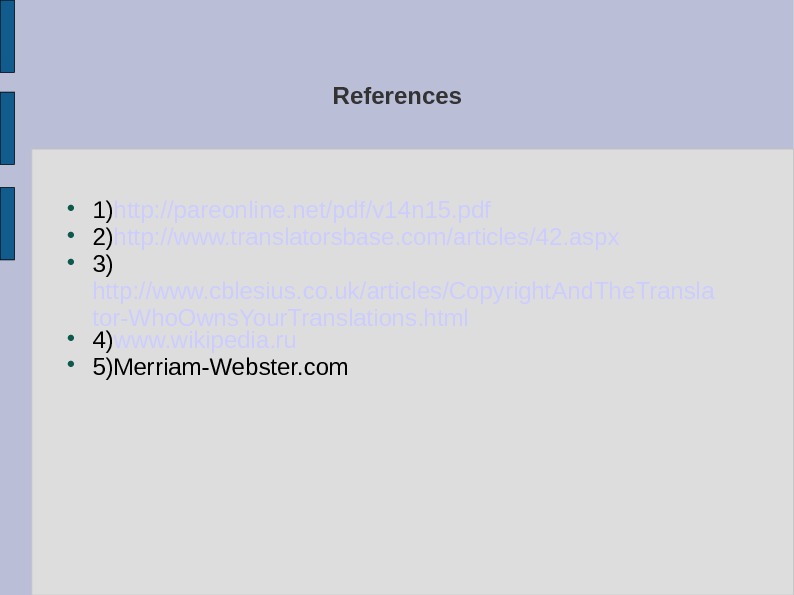
- Размер: 312.5 Кб
- Количество слайдов: 14
Описание презентации AUTHORSHIP(COPYRIGHT)PRACTICE IN TRANSLATION Done по слайдам
 AUTHORSHIP(COPYRIGHT)PRACTICE IN TRANSLATION Done by: Turdieva I. Omarova E.
AUTHORSHIP(COPYRIGHT)PRACTICE IN TRANSLATION Done by: Turdieva I. Omarova E.
 CONTENTS Definitions Introduction Main Part Conclusion References
CONTENTS Definitions Introduction Main Part Conclusion References
 Definitions 1)Copyright-the exclusive and assignable legal right, given to the originator for a fixed number of years, to print, publish, perform, film or record literary, artistic or musical material 2)Berne Convention-one of the three major international copyright treaties. Based on the principle of national treatment, provides certain minimum protection for specified types of works(such as 50 years for authors), and forbids imposition of technicalities such as a copyright notice.
Definitions 1)Copyright-the exclusive and assignable legal right, given to the originator for a fixed number of years, to print, publish, perform, film or record literary, artistic or musical material 2)Berne Convention-one of the three major international copyright treaties. Based on the principle of national treatment, provides certain minimum protection for specified types of works(such as 50 years for authors), and forbids imposition of technicalities such as a copyright notice.
 Introduction As we know, in todays world thousands of pages of original work are produced by professional translators every day. But what happens to them? Who owns copyright? The Copyright Act provides that copyright subsists in any original work of authorship that is fixed in a tangible medium of expression. Originality means that the work was not copied from some-one else and possesses at least a small amount of creativity. So, the question is: Does the work of translators meet the requirements for copyright? The matter has been debated for years. As we all are future translators we want to now your opinion : Will you wonder what becomes of the work you are proud of and will you regret that this work remains anonymous? Would you really mind if someone chose to make changes to your creation without informing you? So, The aim of this project is to clearly explain what is “Authorship practice in translation”. In order to develop theme of this project we tried to explain it achieving three objectives: 1)What is copyrigh? 2)Copyright in Translation 3)Permissions from owner of the work To conclude, we want to say that if you make a transaltion your transaltion should be protected for copyright. If you make a translation into English of a French work in France, your translation will be protected in France under French law. If you do the same in England, it will be protected under English law; in America under American law. Therefore there is no unified legal system governing the protection of your works around the world. You have to examine the law of each separate jurisdiction to find out what rights you have as an author/translator. Structure: 1 st stage: Copyright in Transaltion; The legal rights of copyright owner; How long does the copyright lasts; 2 nd stage: Types of permission 3 rd stage: Berne Convention
Introduction As we know, in todays world thousands of pages of original work are produced by professional translators every day. But what happens to them? Who owns copyright? The Copyright Act provides that copyright subsists in any original work of authorship that is fixed in a tangible medium of expression. Originality means that the work was not copied from some-one else and possesses at least a small amount of creativity. So, the question is: Does the work of translators meet the requirements for copyright? The matter has been debated for years. As we all are future translators we want to now your opinion : Will you wonder what becomes of the work you are proud of and will you regret that this work remains anonymous? Would you really mind if someone chose to make changes to your creation without informing you? So, The aim of this project is to clearly explain what is “Authorship practice in translation”. In order to develop theme of this project we tried to explain it achieving three objectives: 1)What is copyrigh? 2)Copyright in Translation 3)Permissions from owner of the work To conclude, we want to say that if you make a transaltion your transaltion should be protected for copyright. If you make a translation into English of a French work in France, your translation will be protected in France under French law. If you do the same in England, it will be protected under English law; in America under American law. Therefore there is no unified legal system governing the protection of your works around the world. You have to examine the law of each separate jurisdiction to find out what rights you have as an author/translator. Structure: 1 st stage: Copyright in Transaltion; The legal rights of copyright owner; How long does the copyright lasts; 2 nd stage: Types of permission 3 rd stage: Berne Convention
 Main Part: What is copyright? Copyright is an entirely legal concept. Under the Anglo-Saxon system, it is a property right, protected by statute, which subsists in literary works. In order to be recognised by law, it has to have a material expression and involves action. As an Anglo-Saxon concept it was originally developed by English judges and was then taken up in North America by the American courts. It generally equates with the Continental European concept of copyright but some of the subtler forms of enforcement and the documentation that is required are different. The term ‘copyright’ is selfexplanatory. It is the right to copy. This means that if you own the copyright in a literary creation you can prevent other people copying your work, issuing copies to the public, lending, renting out your work, and performing it in public (but not in private). You can also stop them from broadcasting it, making an adaptation or a translation of it. This last point is important because a translator can only translate or adapt a work (to the extent that an adaptation is involved) with the consent of the original copyright owner. However, if this consent is granted and the translation is then produced, the work of the translator – who essentially is an author, too – is itself protected by copyright.
Main Part: What is copyright? Copyright is an entirely legal concept. Under the Anglo-Saxon system, it is a property right, protected by statute, which subsists in literary works. In order to be recognised by law, it has to have a material expression and involves action. As an Anglo-Saxon concept it was originally developed by English judges and was then taken up in North America by the American courts. It generally equates with the Continental European concept of copyright but some of the subtler forms of enforcement and the documentation that is required are different. The term ‘copyright’ is selfexplanatory. It is the right to copy. This means that if you own the copyright in a literary creation you can prevent other people copying your work, issuing copies to the public, lending, renting out your work, and performing it in public (but not in private). You can also stop them from broadcasting it, making an adaptation or a translation of it. This last point is important because a translator can only translate or adapt a work (to the extent that an adaptation is involved) with the consent of the original copyright owner. However, if this consent is granted and the translation is then produced, the work of the translator – who essentially is an author, too – is itself protected by copyright.
 In the days of Einstein, Newton, Dewey, and James scientific authorship was easier. Authorship was specifically traceable to individuals. As science has grown more complex, joint- or multiply- authored journal articles have increased dramatically, and what constitutes authorship has become more of an issue. For example, in the physical and biomedical sciences, an article published in the New England Journal of Medicine in 1993 that reported on the results of an international randomized clinical trial was published with over 900 authors, and a physics article that reported on the Large Hadron Collider was published with almost 3000 authors. And it raised important questions as to what really should count as authorship, and whether authorship might be assigned where it is not due.
In the days of Einstein, Newton, Dewey, and James scientific authorship was easier. Authorship was specifically traceable to individuals. As science has grown more complex, joint- or multiply- authored journal articles have increased dramatically, and what constitutes authorship has become more of an issue. For example, in the physical and biomedical sciences, an article published in the New England Journal of Medicine in 1993 that reported on the results of an international randomized clinical trial was published with over 900 authors, and a physics article that reported on the Large Hadron Collider was published with almost 3000 authors. And it raised important questions as to what really should count as authorship, and whether authorship might be assigned where it is not due.
 Copyright in Transaltion Translation is generally protected by copyright as a literary work. This is separate from copyright in the underlying work, which also may be protected. Does copyright subsist in a translation? Even if translator infringing someone else’s copyright or even if he unlawfully translating someone else’s work, his work will itself qualify for protection as an original copyright. As a translator he/she have created something original. As long as he/she hasn`t not copied someone else’s translation and providing he/she has not pledged his right to someone else, he/she still own the copyright. Who owns the translation? The author owns the translation. As a freelance translator, you as the author own the translation. However if you are an employee or a salaried worker, your employer is the owner of your translation. Authorship does not necessarily mean ownership in copyright terms. Under American law you can sign away your author’s rights.
Copyright in Transaltion Translation is generally protected by copyright as a literary work. This is separate from copyright in the underlying work, which also may be protected. Does copyright subsist in a translation? Even if translator infringing someone else’s copyright or even if he unlawfully translating someone else’s work, his work will itself qualify for protection as an original copyright. As a translator he/she have created something original. As long as he/she hasn`t not copied someone else’s translation and providing he/she has not pledged his right to someone else, he/she still own the copyright. Who owns the translation? The author owns the translation. As a freelance translator, you as the author own the translation. However if you are an employee or a salaried worker, your employer is the owner of your translation. Authorship does not necessarily mean ownership in copyright terms. Under American law you can sign away your author’s rights.
 The legal rights of copyright owners Make an adaptation of the work (this include the right to make a translation); Reproduce the work(for example, by printing, scanning, photocopying or recording); „ publish“the work (this is the right to make the work public for the first time); Communicate the work to the public(for example, by broadcasting the work over TV or radio, or by putting the work online)
The legal rights of copyright owners Make an adaptation of the work (this include the right to make a translation); Reproduce the work(for example, by printing, scanning, photocopying or recording); „ publish“the work (this is the right to make the work public for the first time); Communicate the work to the public(for example, by broadcasting the work over TV or radio, or by putting the work online)
 How long does the copyright last? Copyright generally lasts for the life of the relevant creator plus 70 years. There are various exceptions to this rule including: Where a work was not published, performed in public or broadcast during a creator`s lifetime; Where something was published anonymously or under a pseudonym, and the identity of the creator couldn`t reasonably be ascertained In each of these cases, copyright lasts for 70 years from the end of the year the work was, with permission, first published, performed in public or broadcast
How long does the copyright last? Copyright generally lasts for the life of the relevant creator plus 70 years. There are various exceptions to this rule including: Where a work was not published, performed in public or broadcast during a creator`s lifetime; Where something was published anonymously or under a pseudonym, and the identity of the creator couldn`t reasonably be ascertained In each of these cases, copyright lasts for 70 years from the end of the year the work was, with permission, first published, performed in public or broadcast
 Types of Permission There are several ways the copyright owner may give permission(a licence) to use a work. Licences can be either exclusive or non-exclusive. An Exclusive licence is granted, only the licensee has the right to use the work in the ways specified in the licence. This means that everybody else is prevented from using the work in those ways. To be fully effective, an exclusive licence must be in writing and signed by the copyright owner. Non-exclusive licence-granted, the copyright owner retains the right to use the work and may grant similar licences to others who wish to use the work in the same way When granting any licence, the copyright owner may choose to limit the permission granted by specifying the types of use that are included. Licences may limit permission to use the work: For a specific period of time; Within a particular geographical area(e. g. Australia)or In a certain language (e. g. English language rights); or In any other way that is practical in the circumctances.
Types of Permission There are several ways the copyright owner may give permission(a licence) to use a work. Licences can be either exclusive or non-exclusive. An Exclusive licence is granted, only the licensee has the right to use the work in the ways specified in the licence. This means that everybody else is prevented from using the work in those ways. To be fully effective, an exclusive licence must be in writing and signed by the copyright owner. Non-exclusive licence-granted, the copyright owner retains the right to use the work and may grant similar licences to others who wish to use the work in the same way When granting any licence, the copyright owner may choose to limit the permission granted by specifying the types of use that are included. Licences may limit permission to use the work: For a specific period of time; Within a particular geographical area(e. g. Australia)or In a certain language (e. g. English language rights); or In any other way that is practical in the circumctances.
 Berne Convention The Berne Convention for the Protection of Literary and Artistic Works was finalised in 1886 as the first instrument of international copyright law. The approach was to establish an international baseline standard, to which all member countries were supposed to adhere in their domestic legislation. The means by which individual countries chose to implement the standards under the Convention were left to their authorities. Like other instruments of public international law, the Berne Convention did not have specific measures of enforcement. Instead, the system was based largely on the aspiration towards international consensus in relation to copyright. These conventions form what is called reciprocal arrangements. There are few countries in the world that are not party to the Berne Convention, which means basically you have rights almost anywhere in the world. As of September 2014, there are 168 states that are parties to the Berne Convention. This includes 167 UN member states plus the Holy See
Berne Convention The Berne Convention for the Protection of Literary and Artistic Works was finalised in 1886 as the first instrument of international copyright law. The approach was to establish an international baseline standard, to which all member countries were supposed to adhere in their domestic legislation. The means by which individual countries chose to implement the standards under the Convention were left to their authorities. Like other instruments of public international law, the Berne Convention did not have specific measures of enforcement. Instead, the system was based largely on the aspiration towards international consensus in relation to copyright. These conventions form what is called reciprocal arrangements. There are few countries in the world that are not party to the Berne Convention, which means basically you have rights almost anywhere in the world. As of September 2014, there are 168 states that are parties to the Berne Convention. This includes 167 UN member states plus the Holy See
 The Pirate Publisher-An International Burlesque, satirizes the bility of publishers to take works from one country and publish them in another without paying the original authors
The Pirate Publisher-An International Burlesque, satirizes the bility of publishers to take works from one country and publish them in another without paying the original authors
 Conclusion So, in this project we tried to clearly explain Authorship practice in translation. Regardless of the financial aspect of what the concept means for our incomes, we can use copyright to strengthen our identities as professionals, to take a stand, and assume responsibility for what we create. There a number of ways we can strengthen our profession and our credibility. When we sign our translations, draw up invoices or compile our translation files, we should incorporate a short description in the small print of our terms and conditions. And we should also make sure we monitor the use of our translations. And we should ensure that any piece of work is completed without giving away more than we are prepared to give away. The reality is that most of us spend hours every week in front of a computer screen, trying to make sense, usually on our own, of highly complex documents requiring large amounts of mental energy. Do we really want to stay anonymous for the rest of our careers?
Conclusion So, in this project we tried to clearly explain Authorship practice in translation. Regardless of the financial aspect of what the concept means for our incomes, we can use copyright to strengthen our identities as professionals, to take a stand, and assume responsibility for what we create. There a number of ways we can strengthen our profession and our credibility. When we sign our translations, draw up invoices or compile our translation files, we should incorporate a short description in the small print of our terms and conditions. And we should also make sure we monitor the use of our translations. And we should ensure that any piece of work is completed without giving away more than we are prepared to give away. The reality is that most of us spend hours every week in front of a computer screen, trying to make sense, usually on our own, of highly complex documents requiring large amounts of mental energy. Do we really want to stay anonymous for the rest of our careers?
 References 1) http: //pareonline. net/pdf/v 14 n 15. pdf 2) http: //www. translatorsbase. com/articles/42. aspx 3) http: //www. cblesius. co. uk/articles/Copyright. And. The. Transla tor-Who. Owns. Your. Translations. html 4) www. wikipedia. ru 5)Merriam-Webster. com
References 1) http: //pareonline. net/pdf/v 14 n 15. pdf 2) http: //www. translatorsbase. com/articles/42. aspx 3) http: //www. cblesius. co. uk/articles/Copyright. And. The. Transla tor-Who. Owns. Your. Translations. html 4) www. wikipedia. ru 5)Merriam-Webster. com
